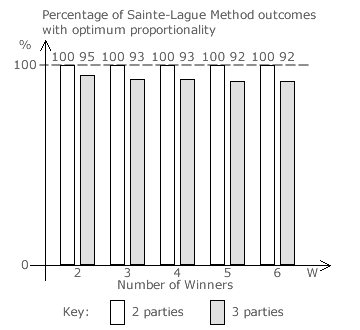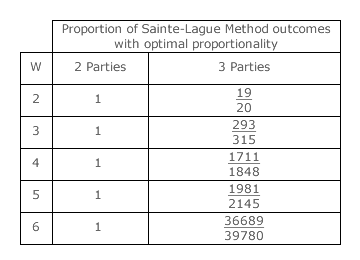Comparisons: Sainte-Laguë ~ Optimality 1
Proportion of Optimal Outcomes in Two- and Three-Party Sainte-Laguë Party-List Elections
On the two-party and three-party maps in the previous section, the Sainte-Laguë domain boundaries are shown as full lines while those of an optimally proportional voting (OPV) system are shown as dotted lines. An OPV system is one where the sum of the magnitudes of the differences between the tally share and seat share for each party is always minimal for any election outcome. In other words, any tally share point within an OPV domain is closest to the seat share dot at the centre of that domain than to any other domain centre.
When the tally shares for any election generate identical seat shares whether the Sainte-Laguë or OPV system is used, then the Sainte-Laguë method here yields optimally proportional results. On the maps, these results occur when the Sainte-Laguë seat share domains overlap with their equivalent OPV ones. On the remaining parts of the maps where the Sainte-Laguë and OPV domains generate dissimilar seat share outcomes, then the Sainte-Laguë method does not produce optimally proportional results.
Therefore, the proportion of optimal outcomes for the Sainte-Laguë method can be expressed as the ratio of those parts of a map that do generate an optimal outcome relative to the map as a whole. As both the Sainte-Laguë and OPV domain boundaries are precisely positioned on the maps, an accurate ratio for any map can be derived by calculating and then summing the relevant areas on a three-party map or the relevant lengths on a two-party map.


The table above provides the exact fractional proportion of optimal Sainte-Laguë method outcomes for two- and three-party elections with up to six winners (W).
The bar chart opposite illustrates these same proportions as percentages rounded to the nearest integer.
[Note: For the three-party map, both the whole area and any component part can be expressed as an exact fraction times the square root of three (√3). When the ratio is calculated, the √3 surd in the numerator and denominator cancel each other out leaving an exact fraction as the answer.]
The divisors of the Sainte-Laguë method were deliberately chosen to optimise proportionality when using the highest averages approach. For two-party contests, it always generates the optimum outcome regardless of the number of seats. For three-party elections, the proportion of optimal Sainte-Laguë method outcomes is very high but not perfect. Optimality is at a maximum with two winners and it barely declines as the number of seats increases. For up to six winners, both two- and three-party Sainte-Laguë Party-List elections generate optimally proportional outcomes in over 90% of all possible cases.
Proceed to next page > Comparisons: Sainte-Laguë ~ Optimality 2
Return to previous page > Comparisons: Sainte-Laguë ~ Maps 3
